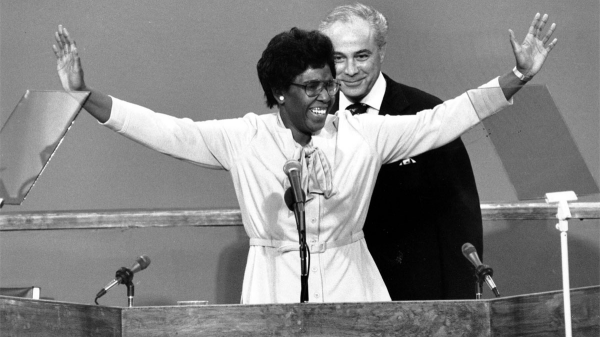Barbara Jordan—a Black woman from Houston’s Fifth Ward—crossed every line drawn to keep her out: the color line, the gender line, the sexuality line, the Mason-Dixon line. And when, 49 years ago this week, the nation asked who would speak for America in crisis, she answered. With conviction. With the Constitution. And with a voice they never forgot.
1/ 20 #history #politics #histodons #blackandwhite
#photography #blackmastodon
Image: Barbara Jordan DNC keynote speech, NYC, July 12, 1976. AP.
1/ 20 #history #politics #histodons #blackandwhite
#photography #blackmastodon
Image: Barbara Jordan DNC keynote speech, NYC, July 12, 1976. AP.

Dr. D. Elisabeth Glassco
•Those lines others had drawn to keep her out were visible in that moment in July. Not to the cameras in Madison Square Garden. But not to the delegates on the convention floor. They heard only the voice.
2/20
Video: Barbara Jordan DNC Keynote Speech, Madison Square Garden , from July 12 to July 15, 1976, Pt. 1.
https://youtu.be/Bg7gLIx__-k?si=_jdDQ8REDPvZ7Ce-
Barbara Jordan, Democratic National Convention Keynote Speech, 1976, part 1
YouTubeDr. D. Elisabeth Glassco
•It was not the voice of youth. It was the voice of authority. Deep. Slow. Composed. It did not rise in pitch but in weight. Every sentence moved with a deliberate cadence, until the room itself leaned toward her.
“We are a people in a quandary about the present,” she said. “We are a people in search of our future.”
It was not a question. It was a diagnosis.
3/20
Video: Barbara Jordan DNC Keynote Speech, Madison Square Garden , from July 12 to July 15, 1976, Pt. 2.
https://youtu.be/2YvxjfoOJLw?si=9XZsnWgxto9VWFlN
Barbara Jordan, Democratic National Convention Keynote Speech, 1976, part 2
YouTubeDr. D. Elisabeth Glassco
•4/20
Image: Sleet, Moneta, Jr. Barbara Jordan and Andrew Young, photograph, 1967, accessed July 16, 2025),University of North Texas Libraries, The Portal to Texas History, Texas Southern University.
Dr. D. Elisabeth Glassco
•5/20
Image: Young Barbara Jordan with her sisters. L to R: Barbara Jordan, Rose Mary McGowan, Bennie Craswell, c. 1950-1960s (African American Library at the Gregory School).
Dr. D. Elisabeth Glassco
•6/20
Image: Edith S. Sampson, Library of Congress, Photograph by Carl Van Vechten, April 6, 1949.
Dr. D. Elisabeth Glassco
•But the line was already there. She could not attend the University of Texas—because she was Black. So the state built a separate school: Texas Southern University. No campus. No history. No budget.
7/20
Image: Barbara Jordan at Texas Southern University, photograph, accessed July 14, 2025),University of North Texas Libraries, The Portal to Texas History, Texas Southern University.
Dr. D. Elisabeth Glassco
•On its debate team, she traveled north. She faced Harvard. She tied them.
9/20
Image: Texas Southern University Oratorical Debate Team], photograph, July 1952, accessed July 14, 2025),University of North Texas Libraries, The Portal to Texas History, Texas Southern University.
Dr. D. Elisabeth Glassco
•10/20
Image: Ballington and Maud Booth Award: Barbara Jordan Awarded], photograph, 1975~; accessed July 14, 2025),University of North Texas Libraries, The Portal to Texas History, crediting Texas Southern University.
Dr. D. Elisabeth Glassco
•“If we cease to be one nation, who then will speak for America?”
The answer, that night, was clear.
She would.
11/20
Video: Barbara Jordan Oral history interview March 28, 1984. LBJ library.
https://youtu.be/y5iWyv-FeyM?si=G4sK9akxqnLvb9B5
Barbara Jordan Oral History Interview I, 3/28/84.
YouTubeDr. D. Elisabeth Glassco
•Two years before, in 1974, she spoke during the House Judiciary hearings on Watergate. Quiet. Resolute. Rooted in the Constitution. No bluster. No theater. She did not ask for applause—only for accountability.
12/20
Video: Barbara Jordan speech at Nixon impeachment inquiry.
https://youtu.be/UG6xMglSMdk?si=ltqGBJppAkp_yLfF
B Jordan impeachment speech
YouTubeDr. D. Elisabeth Glassco
•And still, when the party asked her to speak again in 1992, she did—this time in a wheelchair.
13/20
Video: Barbara Jordan 1992 speech at the Democratic convention.
https://youtu.be/ADDsKGs6Gr4?si=C8dDRD0xYj9C0qDt
Barbara Jordan speaks at the 1992 Democratic Convention
YouTubeDr. D. Elisabeth Glassco
•14/20
Image: Barbara Jordan, Oct 18, 1976 (Lyndon Baines Johnson Presidential Library).
Dr. D. Elisabeth Glassco
•But she knew.
“I wanted to be a citizen,” she once said.
And in 1976, she reminded America what that meant—not by heritage, but by will.
And though many forgot the details, they remembered the voice.
Because she had crossed the line.
And she had spoken for the common good.
15/20
Image: Barbara Jordan as a young woman. Source: Office of the Clerk, U.S. House.